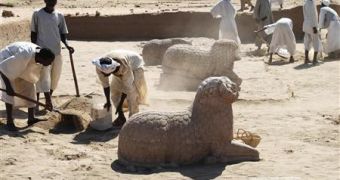Three ancient statues representing the African animal-god Amun were unearthed at el-Hassa, in Sudan, nearly three weeks ago, some 200 kms (120 miles) to the north of the capital city of Khartoum. The statues bear inscriptions that could help experts understand an ancient tongue, one of the few left undeciphered in the entire world. Also, the references to king Amanakhareqerem may shed more light on the importance of the respective personality.
The stone rams belong to an old period of Africa's history, the Meroe age, estimated to have extended for seven centuries and a half, between 300 BC to 450 AD, when kings ruled supreme. An extensive amount of remains can still be found dating from the Meroitic period by the Nile river. A legacy of the Meroitic people also resides in each inscription on the statues, representing the most ancient written tongue in sub-Saharan Africa.
"It is one of the last antique languages that we still don't understand [...] we can read it. We have no problem pronouncing the letters. But we can't understand it, apart from a few long words and the names of people," revealed Vincent Rondot, director of the dig works developed by the French section of the Directorate of Antiquities in Sudan, as cited by Reuters. The inscription seems to be the complete version of the same royal dedication that was previously discovered only on fragments of carvings, and comparisons could aid specialists in determining the meaning of the words.
Although Sudan is far richer in pyramids than the more famed Egypt, the ongoing Darfur conflict prevents visitors from coming, and it makes research works more difficult. The inscriptions on the statues found under the desert dunes among the ruins of a temple built for Amun may also shed more light on the infamous king Amanakhareqerem. "Before we started the dig we only had four documents in his name [...] We don't even know where he was buried," stated Rondot. "We are beginning to understand the importance of that king."

 14 DAY TRIAL //
14 DAY TRIAL //